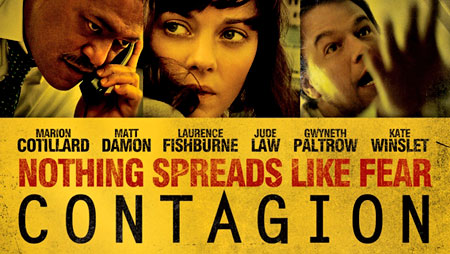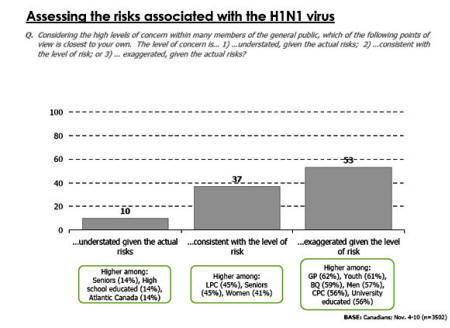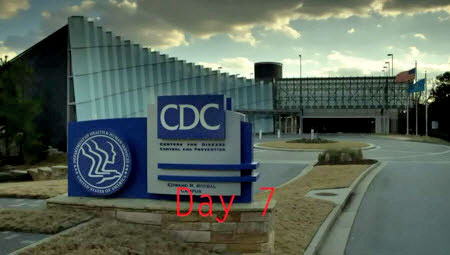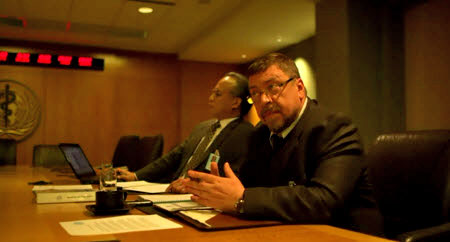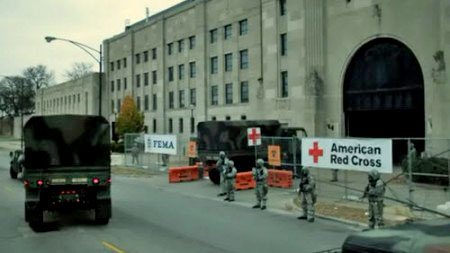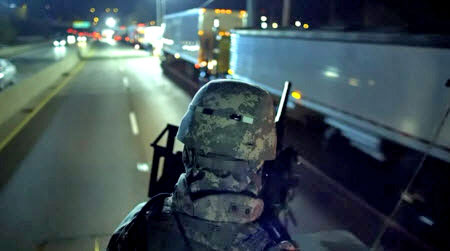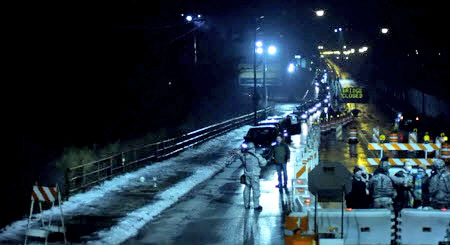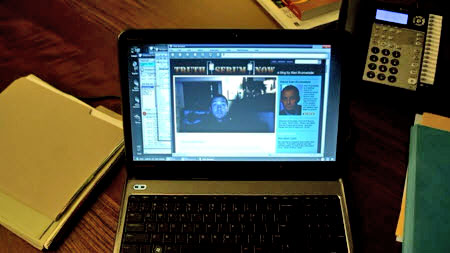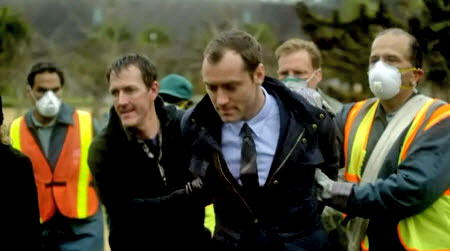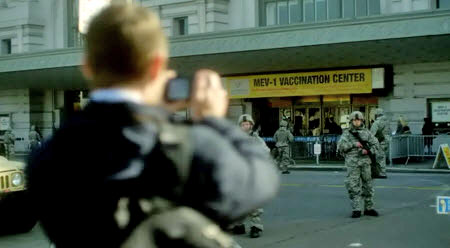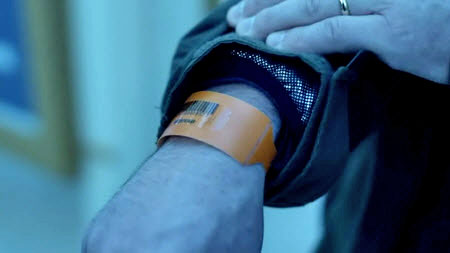|
March 8, 2012
from
VigilantCitizen Website
Most people watch movies to be entertained.
Well, I for one can say that there was absolutely nothing entertaining about Contagion. In fact, the only difference between this movie and state-sponsored educational movies shown in schools is that with Contagion you actually have to pay to be indoctrinated… and to see Matt Damon.
During the cold war, students were shown videos
instructing them to "Duck and Cover" in case of a nuclear attack. Contagion
conditions the masses to expect martial law and to throw themselves at the
first available vaccine in case of a crisis.
Featuring Hollywood mega-stars like Matt Damon, Laurence Fishburne, Jude Law and Gwyneth Paltrow, Contagion is a big-ticket Hollywood movie, but also an infomercial promoting specific national and international agencies while encouraging specific behaviors from the public.
The plot of the movie appears to follow the big H1N1 scare of 2009 that left many citizens uncertain about the actual risk of the virus.
Indeed, after months of terrifying news crowned
by a massive vaccination campaign, an important portion of the population
concluded that the H1N1 scare was grossly exaggerated and and thought that
a
vaccine was unnecessary. This poll taken in November 2009 shows that 53% Canadians believed that the risks associated with
the H1N1 virus were
exaggerated. In the wake of this "crisis", the UN's World Health Organization (known as the WHO) was harshly criticized and even accused of colluding with Big Pharma to sell vaccines.
The U.S. Centers for Disease Control and Prevention (the CDC) also had its credibility tarnished as investigations revealed that the agency misled the public regarding the number of actual cases of H1N1 (for example, see this report from CBS News).
As a result,
these two agencies needed a good PR stunt to restore their credibility and
to scare the hell out of the public. This is where Contagion comes in.
Nothing in the movie hints that it is a work of fiction. Quite to the contrary, everything in Contagion is made to be as realistic as possible, using actual locations and governmental agencies, to make the story as plausible - and as frightening to the masses - as possible.
As the slogan of the movie says:
This movie's message is:
The Function of Disaster
Movies
While some are very over-the-top and border on fantasy, others, like Contagion, emphasize realism and actual events. These movies tend to "hit home" with the viewers because they lead them to think "this could happen to me".
Disaster movies exploit the latent fear that recent events caused on the psyche on the masses, tapping into the anxiety and trauma they cause in order to create tension and terror in the viewers.
Then, the "agenda" aspect of these movies kick in as they propose to the viewers the best (and only) way these issues can be resolved.
Specific groups and agencies are cast as
honorable, helpful and trustworthy during the time of crisis, while others
are portrayed as hindrances and even traitors. The drama that follows
becomes a case of predictive programming, as the steps taken in the movie to
resolve the problem will thereafter appear normal to the masses if they ever
occur in real life.
Along with the all-importance of authorities, the masses are inevitably presented as a herd of idiots prone to panic that must be kept in the dark.
Contagion follows Ramonet's blueprint of disaster movies to a tee.
Right from the start, specific organizations are identified as the go-to guys and are automatically given the power to act on a massive scale, namely, So what solution does Contagion propose in case of the outbreak of deadly disease? Martial law and mass vaccinations.
What will happen if ever an actual disease would break out? Martial law and mass vaccinations. Would the masses questions this type of drastic response to a crisis which might or might not be necessary? No, because hundreds of hours of media content have prepared the masses for this kind of situation.
Let's look at the main components and messages found in Contagion.
The point of the introduction is simple:
This realistic yet terrifying scenario is a very effective way to grip the audience and to cause a state of fear.
During these scenes, the camera focuses for a few extra seconds on common objects that can transmit germs such as drinking glasses, just long enough for the viewer to realize:
This sick guy could infect the entire bus.
To add to the drama and scare
factor, they name big cities and their population.
Most of those who are infected with the virus do not live long.
In a series of heartbreaking scenes, one of the main characters, Mitch Emhoff (played by Matt Damon), sees his wife and his son lose their lives to the virus.
Viewers watching this tragedy play out are led to think,
Watching Beth Emhoff (played by Gwyneth Paltrow)
die from the virus is quite
disturbing and certainly helps create a climate of fear. This movie was released only a two years after the outbreak of H1N1 and the media hype that surrounded it, so that fear is still latent in many people. These scenes from Contagion reactivates the "fear virus" that was planted in people… and adds some.
After a few minutes of panic-inducing scenes, most viewers will say,
Heroes do step up to the plate and take charge
of things… and it just so happens that they were involved in the making of
the movie.
Meanwhile, specific real-life non-government organizations (NGOs) are identified by the movie as the "heroes" and the go-to people to handle the crisis. These organizations are promoted to the viewers and are given automatic legitimacy and trustworthiness.
However, those who are educated about the world elite's agenda for a New World Order know that these organizations have been know to push that agenda and everything that goes with it.
In short, the movie says:
The agencies identified by the movie are:
So, in the wake of a "biological crisis", the democratically elected American government basically dissolves and specific organizations (CDC, WHO, FEMA, the U.S. Army) take charge of all aspects of society.
And this "taking charge" proceeds in a very
specific way: Martial law and civilian camps.
Martial Law
First, the general population, always depicted as idiotic, cattle-like and prone to violence, spirals out of control. The masses are always shown panicking, yelling, stealing, fighting and looting.
This leads to a general breakdown of social
order and a state of lawlessness.
A bunch of rude people
looting a pharmacy to obtain medication. Wherever regular people are put together, all sort of crap ensues. This goes along with the concept of "infantilization" of the masses, who require to be taken charge by "fatherly" authorities.
And boy do the authorities take over.
The US Army imposes Martial Law and places the State of Minnesota in quarantine, blocking all traffic out of the state. Those who seek to leave the state
are told to turn around and
go back home.
Citizens are then directed to
FEMA camps.
This stadium has been turned
into a FEMA camp.
where they are fed and lodged. In this scene, the lack of "individual meals" to feed all of the camp's population causes a small riot.
Personified by a blogger named Alan Krumwiede (played by Jude Law), alternative media are presented as unreliable sources bent on sensationalism and profit. In other words, the movie implies that information that does not come from "official" sources is invalid and potentially dangerous.
Not exactly a pro-free-speech message.
"Truth Serum", a blog run by Alan Krumwiede, resembles the many "alternative news" website around the web. This type of information, which does not come from mass media
or governmental sources, is
definitely not portrayed in a positive light. Right from the start, Alan Krumwiede is portrayed as a somewhat dodgy blogger with a questionable work ethic and who does not get much respect from the journalistic nor the scientific community.
When he tries to get one of his stories published in a newspaper called The Chronicle, he gets rejected due to lack of evidence behind his story.
When he contacts a scientist regarding the virus, the scientist replies:
Despite this lack of respect from "competent" bodies, Alan Krumwiede has a wide audience and proudly boasts "millions of unique visitors per day" on his website.
On it, he claims that a cure for the MEV-1 virus
exists and is named Forsythia but it is repressed by the powers that be to
sell vaccines. He also urges his readers not to take the vaccine that is
given out by authorities.
When he discovers the ploy against him the agent tells Krumwiede:
Government agents then appear out of nowhere and arrest Krumwiede for,
Krumwiede is arrested due to the contents of his blog. Contagion sends out a powerful message against "alternative" information sources:
Diverging from "official
sources" is dangerous and 'against the law.' It is later learned that Forsythia was a lie and that Krumwiede made 4.5 million dollars by promoting it to his readers. The chief of Homeland Security wants to put him in jail for a "long, long time".
However, due to his popularity, Krumwiede makes bail because, as the chief of Homeland Security states:
The character of Alan Krumwiede and the way he is portrayed is interesting for several reasons.
By associating the corrupt figure of Alan Krumwiede with the "anti-vaccine movement", the movie discredits all of those who question the necessity of mass vaccination campaigns.
If another virus should strike, viewers of Contagion might be more prone to ignore these movements.
In other words, the movie says:
The only solution to do virus problem?
A mass vaccination campaign.
Those who receive the vaccine get the privilege
of wearing a scannable wristband. This allows them to go to public places
such as shopping malls.
You get vaccinated, you get a barcode and go places. You don't get vaccinated, you stay at home... and you die.
To do so, the movie defines a specific problem that has actually occurred in the past, it identifies the agencies that have the right to take charge of the situation and proposes the only solution required to fix the problem.
That solution is not pretty:
Are disaster movies such as Contagion solely created for entertainment or are they also used to teach the public about what is acceptable and what is not when a disaster occurs? Would the World Health Organization participate in a movie simply to entertain people?
Interesting fact:
The WHO has also recently allowed the publication of controversial research describing the creation of a mutant and highly contagious version of the virus.
Could a weaponized version of the virus be purposely released on the public to justify martial law? Wait, maybe I shouldn't say things like that.
I don't want to get arrested for,
|

